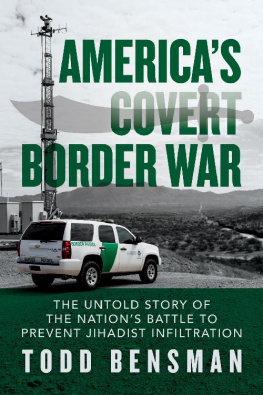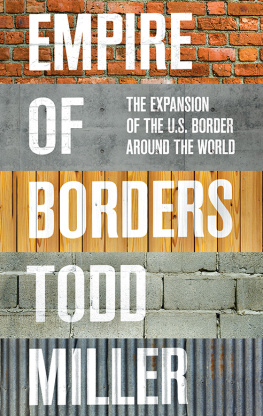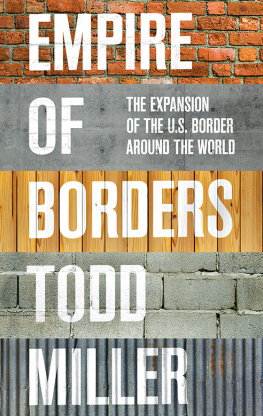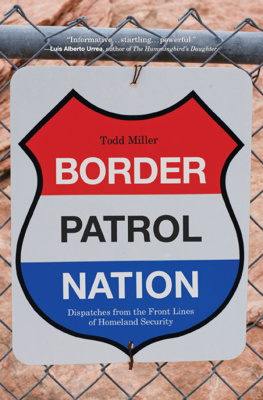Todd Bensman - Americas Covert Border War
Here you can read online Todd Bensman - Americas Covert Border War full text of the book (entire story) in english for free. Download pdf and epub, get meaning, cover and reviews about this ebook. year: 2020, publisher: Post Hill Press, genre: Politics. Description of the work, (preface) as well as reviews are available. Best literature library LitArk.com created for fans of good reading and offers a wide selection of genres:
Romance novel
Science fiction
Adventure
Detective
Science
History
Home and family
Prose
Art
Politics
Computer
Non-fiction
Religion
Business
Children
Humor
Choose a favorite category and find really read worthwhile books. Enjoy immersion in the world of imagination, feel the emotions of the characters or learn something new for yourself, make an fascinating discovery.
- Book:Americas Covert Border War
- Author:
- Publisher:Post Hill Press
- Genre:
- Year:2020
- Rating:5 / 5
- Favourites:Add to favourites
- Your mark:
- 100
- 1
- 2
- 3
- 4
- 5
Americas Covert Border War: summary, description and annotation
We offer to read an annotation, description, summary or preface (depends on what the author of the book "Americas Covert Border War" wrote himself). If you haven't found the necessary information about the book — write in the comments, we will try to find it.
Americas Covert Border War — read online for free the complete book (whole text) full work
Below is the text of the book, divided by pages. System saving the place of the last page read, allows you to conveniently read the book "Americas Covert Border War" online for free, without having to search again every time where you left off. Put a bookmark, and you can go to the page where you finished reading at any time.
Font size:
Interval:
Bookmark:

CH APTER FIVE
When the Gringos Came: T he Far War
The region is also home to networks that specialize in smuggling illegal immigrants from places like Afghanistan, Pakistan, Yemen, Syria, and Iraq, all places where terrorist organizations like al-Shabbab, ISIS, al-Qaeda and their affiliates operate. Now migrant smuggling is not uncommon. What makes these networks different is the type of people who enlist their services to attempt to enter the U.S. homeland undetected. Some of these people have ties to terrorism and some have intentions to conduct attacks in the homeland.
Rear Admiral Brian Hendrickson, US Southern Command, congressional testimony on May 23, 2018.
I n the early years after 9/11, when the Americans were still figuring out how to guard the nations open southern flank, an Afghan traveler caught in Mexico caused such terrorism alarm that he ended up at Guantanamo Bay, Cuba, in the notorious American military prison camp reserved for the most hardened of terrorist prisoners. There, in 2003, the US military authorities deemed Feda Ahmed, who admitted he was on his way to cross the American border, an enemy combatantbased on information possessed by the United States that indicates that the detainee is associated with a l-Qaida.
The partial story of Feda Ahmed, a designated al-Qaeda enemy combatant who almost succeeded in reaching the American border, is revealed in declassified records and military tribunal hearing transcripts the government was forced to release after an Associated Press Freedom of Information lawsuit in May 2005. But the documents reflecting the 2002 capture of Ahmed in Mexico and subsequent imprisonment at Guatanamo Bay, almost unbelievably attracted no media reportage even as it has resided on a New York Times database for years. Not even the Department of Defenses final 2004 intelligence assessment about Feda Ahmed seemed to interest the reporters at the newspaper holding the documents, the wire service that litigated in federal court to get it, or any other reporter who might have read the declassified materi als later:
Detainee is a suspected al-Qaeda terrorist captured in Mexico attempting to reach the US border.
According to the material, Feda told his American interrogators after his Mexico arrest that, shortly after the US invasion of Afghanistan in 2001, his father in Kandahar paid $25,000 to a smuggler named Khaled to get him over the American border. Khaled was apparently part of the international smuggling network run out of Quito, Ecuador by the Jordanian-Palestinian Maher Jarad, who worked closely with smugglers for the US-designated terrorist groups Hezbollah and al-Gamaa al-Islamiyya of Egypt. Jarad had been sending his Middle East clients from Ecuador to Mexico aboard merchant ships, then overland to the US border. In February 2002, Ahmed and an apparent subordinate in the Jarad network, an Afghan identified as Ahmed Jan, whom US investigators said also was directly linked to Hezbollah and al-Gamaa al-Islamiyya, flew together to Ecuador on forged travel documents, including passports. In Ecuador, Jarad put the pair on a ship headed to Mexicos Chetumal port, through the Panama Canal. But after 9/11, the Americans were determined to shut down that ocean smuggling route. With the Mexican Navy, the American Coast Guard and Immigration and Naturalization Service set up the joint Operation Southern Watch (alternatively known as Operation Southern Focus) to disrupt Jarads SIA-shipping scheme. In March 2002, the Mexicans arrested Ahmed and Jan, according to the declassified material.
Mexico hung on to both men for three months, no doubt while American intelligence officers interrogated them, then deported at least Feda back to Afghanistans capital, Kabul. The Afghan government put him in prison for another ten months, and then, for unknown reasons, handed him over to the US authorities, who shipped him to Guantanamo Bay on May 9, 2003.
The reasons for imprisoning Ahmed at Guantanamo Bay are listed in the documents: To provide specific information on terrorist networks, financing, facilitators, recruiters, and travel in Afghanistan, Pakistan, and Mexico. But he was also deemed to be associated with al-Qaeda.
At one point, Ahmed told the Tribunal president at the prison that he was going to the United States through Mexico because I was going to find a job to make some money. But American interrogators caught Ahmed lying about everything, his trip, his family, his travels, whether he could read and write, what languages he spoke, and his work. All the lying was not indicative of someone simply trying to enter the US, a 2004 intelligence assessment of Ahmed concluded.
The Americans tagged Ahmed as a moderate threat to the US, a designation that was downgraded over time to low, at which point he was transferred back to Afghanistan on April 18, 2005.
That early post-9/11 instance of a suspected terrorist attempt to reach the US southern border occurred in the nascent stages of an American effort that would evolve into distinct but related counterterrorism operations and spread throughout the Americas.
As described in Chapters Two and Three, America shored up its physical land borders after 9/11 in a near war to filter against expected Islamic jihadist terror infiltrations of the sort that have bedeviled Europe. New laws requiring the prevention of terrorist infiltrations at the land borders led to expanding Border Patrol and extending walls along the Mexican line. As we have seen, the FBI, DHS agencies, and sometimes military and CIA intelligence officers (and for a time my Texas Department of Public Safety team) have conducted enhanced security vetting investigations and face-to-face threat assessment interviews with SIAs who get apprehended. Most of the suspected jihadists are deported in a better-safe-than-sorry gambit. These efforts almost certainly prevented jihadist attacks from the southe rn border.
But in one of Americas most expansive and audacious other unknown counterterrorism projects, the United States mounted what I call a far war to ensnare jihadist migrants before they reach the homeland border. Even before the Feda Ahmed case, homeland security sent officers and intelligence personnel to stand watch and to track and neutralize the few-and-far-between jihadist travelers, almost always by causing deportations. In the years since, hundreds have been added to expand and improve the programs. American homeland security leaderships established tripwire systems to do this detection work in partnership with regional governments willing to be trained, equipped, and prepared to act in certain ways when the time comes to nab, hold, and deport suspected traveling terrorists like Ahmed. The other American endeavor was to bust the terrorist-sympathizing SIA smugglers, like Maher Jerod, who made the long-haul jihadist journeys possible.
For the first bunch of years we started doing this, we didnt see much, my DHS veteran of this far-war told me. But as we got better and better, getting better with the processes, we started seei ng them.
Feda Ahmed the client and Maher Jerod the smuggler stand as some of the first enemy casualties in the early days of this American far war, representative of its targets. Those two have much co mpany now.
Setting Tripwires for Jihadists
Acting on a US Homeland Security Investigations Wanted Alert in June 2019, Nicaragua arrested four suspected ISIS jihadists who had just crossed their border on a journey north to the United States. The US Department of Homeland Security blasted the bulletin to Central American governments and Mexico, identifying two of the Iraqis and one of the Egyptians and urged their captures so that they could be questioned. A fourth man, an Egyptian, had been traveling with the three when the Nicaraguans detained them. A collective sigh of relief passed quietly among those staffing an American intelligence apparatus that had been set up throughout the region many year s earlier.
Next pageFont size:
Interval:
Bookmark:
Similar books «Americas Covert Border War»
Look at similar books to Americas Covert Border War. We have selected literature similar in name and meaning in the hope of providing readers with more options to find new, interesting, not yet read works.
Discussion, reviews of the book Americas Covert Border War and just readers' own opinions. Leave your comments, write what you think about the work, its meaning or the main characters. Specify what exactly you liked and what you didn't like, and why you think so.











